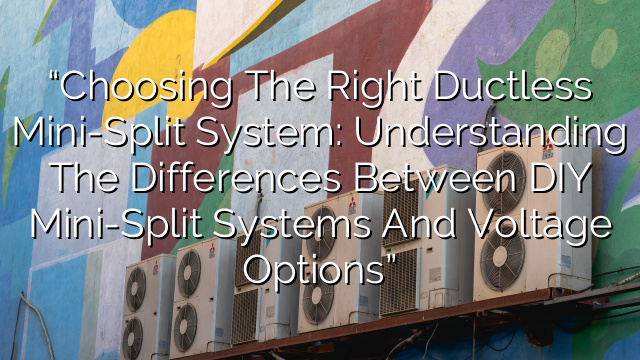Benefits of Ductless Mini Split Systems
When it comes to HVAC systems, ductless mini split systems are becoming increasingly popular. Unlike traditional systems, which use a network of ducts to distribute air throughout a building, mini split systems allow for ultimate airflow control without the need for ductwork.
1. Energy Efficiency:
Mini split systems are incredibly energy efficient. Because each unit operates separately from the others, you can easily control the temperature in individual rooms or zones. This allows you to avoid wasting energy on heating or cooling rooms that are not in use, potentially saving you a significant amount of money on your energy bills.
2. Easy Installation:
One of the biggest advantages of ductless mini split systems is their DIY-friendly installation process. Since they require no ductwork, installation is much simpler and less invasive compared to traditional HVAC systems. In fact, most homeowners with basic DIY skills can install a ductless mini split system themselves, saving on installation costs.
3. Improved Air Quality:
Since ductless mini split systems don’t rely on ductwork to distribute air, there is less opportunity for dust, dirt, and other allergens to build up. This can lead to improved air quality, particularly for those who suffer from allergies or respiratory conditions.
4. Increased Comfort:
With a traditional HVAC system, it can be difficult to achieve consistent temperatures throughout a building. However, with a ductless mini split system, each unit operates independently, allowing for precise temperature control in different areas. This means that you can set the temperature to your desired level for each room or zone, ensuring optimal comfort for everyone in the building.
5. Versatility:
Ductless mini-split systems are incredibly versatile and can be used in a variety of settings. Whether you need to heat or cool a single room, multiple rooms, or an entire building, there is a wide range of mini-split system options available to suit your needs.
DIY Mini-Split Systems
Ductless mini split systems are designed to be user-friendly, making them an ideal choice for DIY installation. With a few basic tools and some basic electrical knowledge, you can easily install a mini split system in your home or business.
However, it’s important to note that while the installation process is relatively straightforward, it does require careful planning and attention to detail. It’s always a good idea to consult the manufacturer’s instructions and guidelines before beginning the installation process.
Airflow Direction: Upflow, Horizontal, Downflow
Ductless mini split systems allow for ultimate airflow control, with the ability to direct air in multiple directions. Depending on the model and installation, you can choose from three main airflow directions: upflow, horizontal, and downflow.
1. Upflow:
Upflow airflow direction refers to air being blown upward from the indoor unit. This is often used in applications where the indoor unit is installed high on a wall, near the ceiling. Upflow airflow direction can help distribute air evenly throughout the room and is particularly effective for heating or cooling larger spaces.
2. Horizontal:
Horizontal airflow direction refers to air being blown horizontally from the indoor unit. This is commonly used in applications where the indoor unit is installed on a wall at a standard height. Horizontal airflow direction is ideal for heating or cooling rooms with lower ceilings or where air distribution needs to be directed in a specific direction.
3. Downflow:
Downflow airflow direction refers to air being blown downward from the indoor unit. This is often used in applications where the indoor unit is installed lower on a wall, near the floor. Downflow airflow direction can help provide more targeted heating or cooling to specific areas and is particularly useful for rooms with high ceilings.
Ductless mini split systems offer a DIY-friendly solution for homeowners and business owners who want ultimate airflow control without the need for ductwork. With their energy efficiency, easy installation, improved air quality, increased comfort, and versatility, these systems are an ideal choice for a wide range of applications.
Whether you’re looking to heat or cool a single room, multiple rooms, or an entire building, a ductless mini split system can provide the precise temperature control you desire. And with the ability to choose from different airflow directions, you can ensure that air is distributed exactly where it’s needed most.
Before embarking on a DIY installation, it’s important to do your research and familiarize yourself with the manufacturer’s guidelines. Take the time to properly plan your installation, ensuring that you have all the necessary tools and materials. If you’re not confident in your DIY skills, it’s always best to consult a professional HVAC technician.
By choosing a ductless mini split system and installing it yourself, you can enjoy the many benefits of these systems while saving on installation costs.
FAQs
- Can I install a ductless mini split system myself?
Yes, ductless mini split systems are designed to be user-friendly and can be installed by homeowners with basic DIY skills. However, it’s important to carefully follow the manufacturer’s instructions and guidelines to ensure a successful installation.
- Are ductless mini split systems energy-efficient?
Yes, ductless mini split systems are highly energy-efficient. Each unit operates independently, allowing for precise temperature control and avoiding the need to heat or cool unoccupied rooms. This can result in significant energy savings and lower utility bills.
- Can ductless mini split systems improve indoor air quality?
Yes, ductless mini split systems can improve indoor air quality. Because they don’t rely on ductwork to distribute air, there is less opportunity for dust, dirt, and other allergens to accumulate. This can be particularly beneficial for those with allergies or respiratory conditions.
- Can ductless mini split systems be used for both heating and cooling?
Yes, ductless mini split systems can be used for both heating and cooling. They offer both heating and cooling modes, making them versatile solutions for year-round comfort.
- How many rooms or zones can a ductless mini split system heat or cool?
The number of rooms or zones that a ductless mini split system can heat or cool depends on the specific system and its capacity. There are single-zone systems that are designed for one room, as well as multi-zone systems that can heat or cool multiple rooms or zones.














